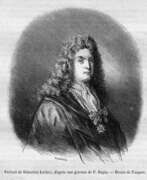Engineers 17th century


Johannes Faulhaber was a German mathematician and fortification engineer.
He was a weaver, but studied mathematics and showed such aptitude that the city authorities appointed him the city mathematician and surveyor, a surveyor. In 1600, Faulhaber opened his own school in Ulm, and worked on the fortification of Basel, Frankfurt, and many other cities. He also designed water wheels in Ulm and made mathematical and geodetic instruments, particularly for military purposes.
Among the scientists with whom Faulhaber collaborated were Kepler and van Ceulen. He made the first German publication of Briggs' logarithms, and also made the first illustrated descriptions of Galileo's compass.


Galileo Galilei was an Italian naturalist, physicist, mechanic, astronomer, philosopher, and mathematician.
Using his own improved telescopes, Galileo Galilei observed the movements of the Moon, Earth's satellites, and the stars, making several breakthrough discoveries in astronomy. He was the first to see craters on the Moon, discovered sunspots and the rings of Saturn, and traced the phases of Venus. Galileo was a consistent and convinced supporter of the teachings of Copernicus and the heliocentric system of the world, for which he was subjected to the trial of the Inquisition.
Galileo is considered the founder of experimental and theoretical physics. He is also one of the founders of the principle of relativity in classical mechanics. Overall, the scientist had such a significant impact on the science of his time that he cannot be overemphasized.


Sébastien Leclerc was a French graphic artist of the second half of the seventeenth and early eighteenth centuries. He is known as a brilliant master of engraving and woodcuts, as well as an art theorist and military engineer.
Leclerc created more than 3,400 engravings during his career, most of them in the religious genre. He was also famous for his illustrations of French literary novels and scientific treatises on art theory, architecture, and geometry.
The artist's son Sebastien Leclerc Jr. and grandson Jacques-Sebastien Leclerc became famous as painters.


Agostino Ramelli was an Italian military engineer and mechanic who worked in the fields of fortification and practical mechanics.
Ramelli studied mathematics, mechanics, and engineering under Giacomo di Marignano, who is considered a disciple of Leonardo da Vinci. He first showed his talents as a mechanic during Louis XIII's military campaign by constructing a mine under a bastion.
Ramelli invented many mechanisms that impressed his contemporaries, including their special aesthetic appeal. His most popular creation is the so-called Ramelli Book Wheel, a rotating reading table. Agostino Ramelli positioned his invention as a sleek design that allowed access to several books without having to get up from his seat.
Ramelli wrote and illustrated a book of engineering projects, Le various et artificiose machine ("Various and Artificial Machines"). The book contains 195 designs, over 100 of which are water-lifting machines, such as water pumps or wells, as well as bridges, mills, and so on. This very interesting book for our contemporaries is still published and is still in demand.


Antonie Philips van Leeuwenhoek was a Dutch microbiologist and microscopist in the Golden Age of Dutch science and technology. A largely self-taught man in science, he is commonly known as "the Father of Microbiology", and one of the first microscopists and microbiologists. Van Leeuwenhoek is best known for his pioneering work in microscopy and for his contributions toward the establishment of microbiology as a scientific discipline.


Hans Vredeman de Vries was a Netherlandish painter and printmaker, decorative artist, architect and Renaissance engineer.
After studying the works of Vitruvius and Sebastiano Serlio and putting in a great deal of labor himself, Vredeman became known throughout Europe as a specialist in perspective. As an architectural theorist, he was most famous for his varied designs of invented views of cities and buildings shown in carefully considered linear perspective. These were apparently created as models for architects.
In 1575-1586 Hans Vredeman de Vries was appointed city architect of Antwerp and was responsible for the fortifications of the city. He then worked in Hamburg, Danzig, Prague and Amsterdam. He is also known for his 1583 publication on garden design and books with many examples of ornamentation and perspective.
His son Salomon Vredeman de Vries (1556-1604) was also an artist.









